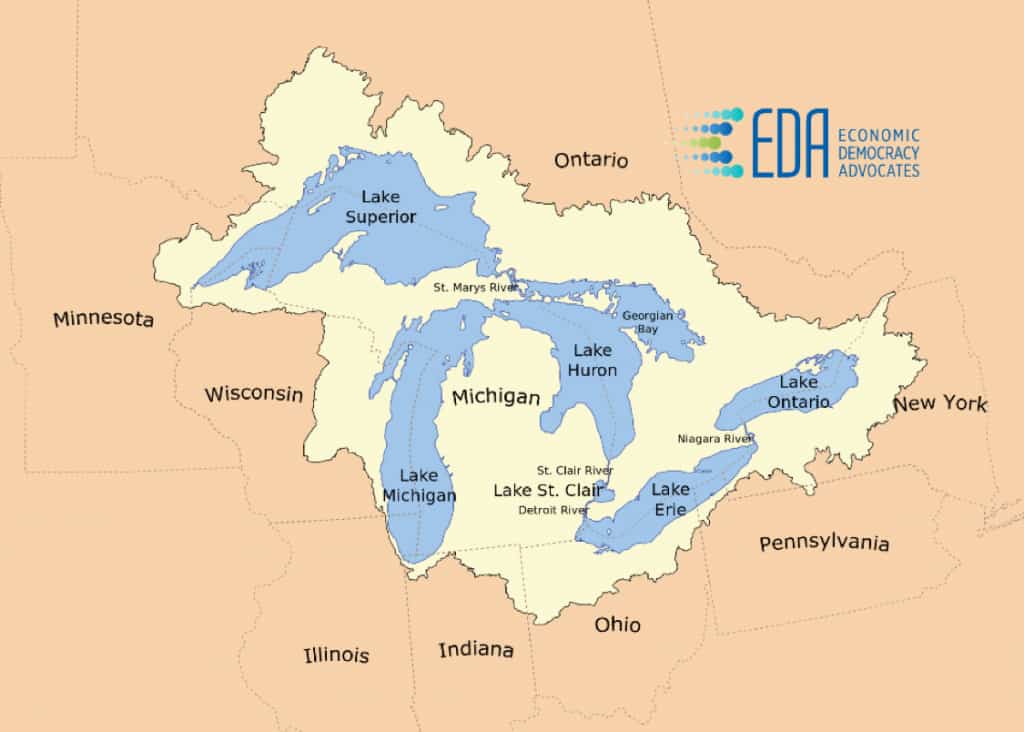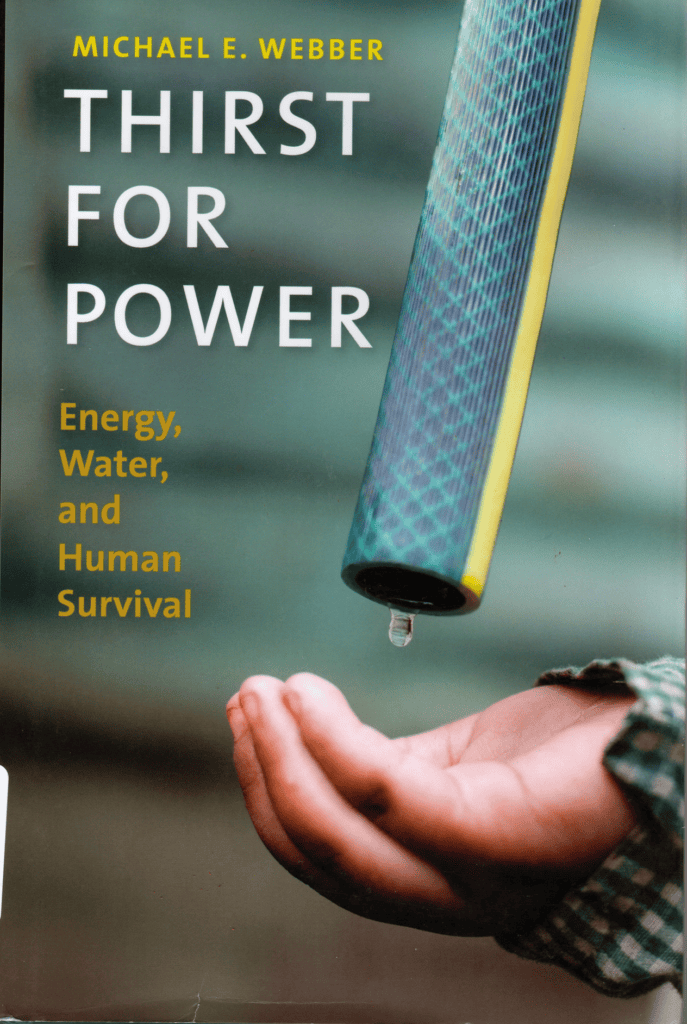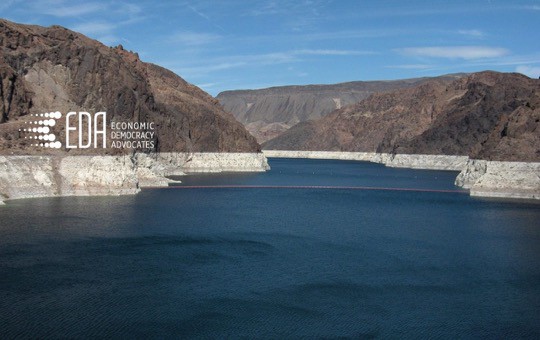Great Lakes Water Basin. Image courtesy of Wikimedia
The new administration of the United States is starting out with an alarming explosion! An early view of the first proposed budget is reflecting catastrophic cuts in funding for the Great Lakes Restoration Initiative. The proposed reduction of between 90 and 97% of funding would decimate the program and could result in irreversible damage to the Commons that our country relies upon. The reduction in 2018 funding from $300 million to just $10 million has caused alarm in environmentalists worldwide.
The reductions would impact compliance monitoring for drinking water safety; grants to protect the beaches of these lakes; protection against invasive species (most notably the Asian carp); wildlife habitat restoration; cleanup of watersheds that had been polluted by industry; and much more.
This article provides an overview of the reductions and the impact these reductions could have on people living in the region. It is imperative that we make our voices known to our Members of Congress that this irresponsible lack of focus on real environmental issues is unacceptable. Read this article and do some additional research on your own – then get out and meet with Members of Congress to voice your concern. We must demand that more attention be placed on protecting our environment. If we don’t, there will be irreversible consequences.

A Great Lakes program that helped spur the local comebacks of lake sturgeon and bald eagles faces its own endangerment.
The Trump administration is considering a drastic cut to funding for the Great Lakes Restoration Initiative, which has also sought to curb algae blooms, invasive species and other water pollution problems in the freshwater lakes.
Funding for the program would be cut from $300 million to $10 million, according to a report by the Oregonian.
The Portland, Ore., newspaper reported that the National Association of Clean Air Agencies obtained a copy of the plan and detailed some of the major Environmental Protection Agency cuts for the paper.
The Great Lakes program has played a key role in several local projects, including cleanup efforts along the Buffalo and Niagara rivers, where shorelines were also improved and wildlife habitat was restored.
The program also relocated Lockport families from a neighborhood contaminated by toxins, removed contaminated sediment from Scajaquada Creek in Buffalo and identified microplastics pollution in Lake Erie.
Rep. Chris Collins said he has supported increased funding for the Great Lakes Restoration Initiative and will keep a close watch on the issue.
“Right now, nothing in the president’s budget has been finalized,” said Collins, a Republican from Clarence who was the first House member to endorse Trump for president. “I am aware of the rumored cuts to the Great Lakes Restoration Initiative and monitoring the situation closely.”
Brian Higgins, D-Buffalo, has championed the Great Lakes Restoration Initiative as a program that helps clean the environment and spur the region’s economic revival.
“I would say to the budget director and to the EPA to come to Buffalo,” said Higgins, who’s vice ranking House member on the Ways and Means Committee and member of the House Budget Committee. “Buffalo is a national model for the effectiveness of these kinds of programs.”
Cutting the program by that much money is tantamount to an “obliteration” of it, Higgins said.
“There’s going to be a fight, and we need to be ready to fight,” Higgins said. “There’s opportunity here for Democrats and Republicans to come together to fight the White House on this.”
Restoration in Jeopardy
It’s not just new efforts now at risk of not getting funded from the Great Lakes program.
“Without that money, we’re putting in jeopardy all that restoration work that’s been done,” said Thomas R. Hersey Jr., Erie County’s commissioner of environment and planning.
“It kind of pulls the rug out from under you,” said Jill Jedlicka, executive director of Buffalo Niagara Riverkeeper. “There are real consequences to the GLRI going away – it will significantly impact the forward momentum for waterfront restoration.”
The Oregonian report revealed programs across the country could be slashed as part of the president’s plan to drastically downsize the EPA by as many as 3,000 employees and the agency’s budget by $2 billion.
Besides the Great Lakes, the report also detailed proposed cuts to restoration efforts in Chesapeake Bay, Puget Sound and the Gulf of Mexico as well as reductions in water quality testing and funding for researching chemicals that disrupt human endocrine systems.
Ten initiatives that are restoring Buffalo Niagara’s Great Lakes
The budget proposal is not expected to be officially released until next week, but reports swirling about the anticipated cuts drew criticism across the country.
“There’s not that much in the EPA, for crying out loud,” Idaho Republican Rep. Mike Simpson told the Washington Post.
Simpson, a former chairman of the House Appropriations subcommittee on interior, environment and related agencies, told the Post he didn’t expect Congress would go along with such drastic cuts.
The Healing Our Waters – Great Lakes Coalition, Great Lakes and St. Lawrence Cities Initiative and other groups like Riverkeeper are taking the reports seriously.
“If true, the level of cuts being discussed would be devastating,” said Chad Lord, policy director for the Healing Our Waters – Great Lakes Coalition. “These cuts will essentially stop restoration efforts in their tracks.”
Restoring a river
The Great Lakes Restoration Initiative was implemented under former President George W. Bush and continued under former President Barack Obama.
The Great Lakes initiative is not a government handout, and that’s what makes it successful, said Higgins and Jedlicka.
The program leverages public and private partnerships that involve local and state agencies, civic organizations, academia and private industry.
The biggest product of the program locally since its inception in 2010 is the Buffalo River’s restoration.
Once declared biologically dead, the river’s resurrection is at hand.
Kayakers now dot the river. There are nature trails and parks along the riverbank. And, more recently, development of luxury apartments are nearing completion along Ohio Street.
The roots of that revitalization were planted when work began to rid the river’s sediment of a century of toxins left over from the city’s industrial heyday.
The river channel was dredged and banks were cleaned of toxic debris. Then, shoreline restoration efforts began to remove invasive species and bring back native habitats to the river corridor.
What’s in peril, if the cuts go through, is maintaining the work that’s been accomplished.
“We’ve got to finish what we’ve started … to get it over the finish line,” Jedlicka said.
Niagara Falls Mayor Paul Dyster, the vice chair of the Great Lakes and St. Lawrence Cities Initiative, said abandoning Great Lakes restoration efforts after years of investments would be tragic.
“A tremendous amount of progress has been achieved,” Dyster said. “That would be lost with these cuts with so much more work left to be done.”
Article written by: By T.J. Pignataro
Published in Buffalo News.com
We recommend you click to the graphic below for an in-depth visual on the Buffalo River Habitat Restoration. It offers tangible examples of the importance of restorative efforts that will be dramatically curtailed with this proposed budget cut.



